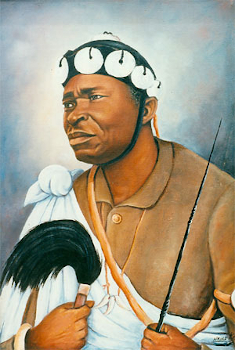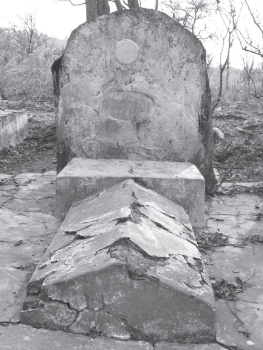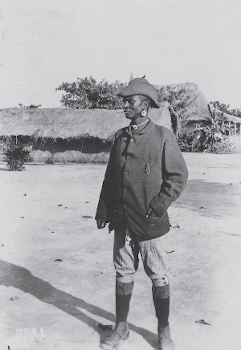The Yeke and the Congo Free State, from confrontation to collaboration
At the end of the 19th century, several Europeans working for Leopold II tried to conquer the territory occupied by the Yeke, a population of present-day Katanga. An examination of the relations between colonisers and the Yeke makes it possible to deconstruct many stereotypes and preconceived ideas that still persist today about the history of Africa and colonisation.

Yeke and Sanga, a history of conflict
Although the Yeke now live in Katanga (DR Congo), their origins lie further east, in present-day Tanzania. The Unyamwezi and traded ivory, copper and slaves with the Arab-Swahili. The latter had already been trading with the Indian Ocean for centuries.
Around 1850, part of the Unyamwezi migrated to an area west of Lake Tanganyika, where they were called Yeke. Their settlement was accompanied by conflicts with the Sanga and other populations already living in the area.
At the instigation of King Msiri, the Yeke established an empire the size of France with Bunkeya as its capital. They had large stocks of ivory and control of the copper and salt mines.
Land and resources were coveted by several populations, resulting in armed conflicts, particularly between Yeke and Sanga. Msiri considered the Sanga's land to be his property, which triggered guerrilla warfare. The Sanga villages were attacked, particularly under the command of Mukanda Bantu, Msiri's son. In response, the Sanga chiefs blockaded commercial convoys of gunpowder and other goods from Angola and the Atlantic coast. Mukanda Bantu managed to re-establish trade routes, but traders were afraid to travel to Bunkeya.
Looking at the relationship between Yeke and Sanga even before the arrival of the Belgian coloniser, it becomes clear that a number of stereotypes about the history of the African continent are wrong:
- There were powerful political and economic structures in Africa. Africans did not live as ‘tribes’ in ‘huts’, independently of each other.
- Like the Europeans, the people of Central Africa moved, often over great distances, and maintained major trade routes, both to the Atlantic coast and to the Indian Ocean. European goods had already arrived in Central Africa before the arrival of the Belgians. One of Msiri’s wives was Maria de Fonseca, daughter of the Portuguese trader Lourenço Souza Coïmbra. The Belgian 'pioneers' did not travel through 'jungles' during their 'explorations'. They used trade routes that were centuries old.
- Land and resources were already being exploited long before the arrival of the Europeans. So the Europeans did not ‘discover’ natural resources. For example, metals such as iron or copper were already being extracted and processed.
- Resources were already the subject of armed conflicts before the arrival of Europeans. Msiri was known for his violence towards his enemies, whom he buried alive up to their necks, close to aggressive ants. His fort in Bunkeya was surrounded by wooden posts on which he impaled the heads of his enemies.
- Lake Tanganyika - now the border between DRC and Tanzania - was not a physical barrier, but rather a zone of contact and exchange. The separation between Central Africa and East Africa is therefore a fictitious border created by the colonisers.
- Finally, the " African" or the "African culture" does not exist. Africa is made up of many heterogeneous societies.
Msiri's power against the Congo Free State
Contrary to what is generally believed, the Congo Free State (CFS) of Leopold II was not recognised at the Berlin Conference of 1884-1885. Its creation was the result of bilateral agreements, notably between the United States and the CFS in 1884. The Belgian Chamber and Senate did not recognise the CFS until after the Berlin Conference.
The creation of the CFS took place without the agreement of African leaders. Consequently, the territory had to be conquered militarily, which is why it was mainly military personnel who was sent in at the beginning, in order to ‘pacify’ the region. The Force Publique (an armed force composed of ‘natives’, exercising the functions of the police and the army of the CFS) was also created in 1885.

In 1889, Leopold II sent Paul Le Marinel, an officer working for the CFS, to Katanga with the mission of signing an agreement between Msiri and the CFS. Msiri had to surrender to the coloniser, draw up an inventory of economic wealth and consent to the construction of a colonial post in Bunkeya.
After a long journey which cost the lives of many porters and soldiers, Le Marinel reached Bunkeya on 18 April 1891. The arrival of more than 300 porters and soldiers – the latter being Hausa from West Africa – made a strong impression on the Yeke. However, on the same day, a stockpile of gunpowder exploded, causing many casualties. This explosion considerably weakened European military power, putting Msiri in a strong position in the negotiations.
After months of negotiations, Msiri refused to submit to the CFS. He also refused the creation of a colonial post in Bunkeya, but authorises a post near the Lofoi river, some 60 km from Bunkeya, a distance impossible to cover in a day, giving Msiri a strategic advantage. Moreover, Msiri knew that this area was regularly flooded and infested with mosquitoes and malaria. He promised to relocate the capital there and trade with Europeans, which he never did. Msiri also asked the Belgians for weapons and ammunition to fight the ‘Arabs’, although what he really hoped was to defeat the Sanga with the help of the Europeans.
When Paul Le Marinel left Bunkeya in June 1891, Msiri still had control of the region. The houses that the Belgians built near the Lofoi river were regularly flooded.
A few months later, in October 1891, Alexandre Delcommune arrived in Bunkeya after a 15-month journey, which again caused many victims. Msiri still refused to surrender to the coloniser. After a few weeks, Delcommune left Bunkeya without having obtained what he wanted.
The end of Msiri
It wasn't until the end of 1891 that Msiri lost power. William G. Stairs and Omer Bodson, who had been received by Leopold II in May 1891, arrived in Bunkeya on 14 December of the same year, accompanied by Joseph A. Moloney, Markies de Bonchamps and Thomas Robinson.
Just a few days later, on 20 December, an armed conflict broke out, during which Msiri and his son Masuka were killed. Bodson was seriously wounded and died shortly afterwards. Stairs had Msiri beheaded and impaled his head on a post, as Msiri did with his own enemies. Large stocks of ivory, copper, gold, weapons, salt, textiles, etc. were seized. Msiri's fort was destroyed and the materials were reused to build ‘fort Bunkéia’. On 30 December, the flag of the CFS was hoisted in Bunkeya.
Msiri’s head was taken by Stairs and the remaining members of the expedition to be brought back to Europe. However, the porters believed that the head was still speaking and that it caused the death of many of them. Msiri's head was therefore abandoned before reaching the coast.
The circumstances in which Msiri, his son Masuka and Bodson lost their lives differ widely according to the sources. Stairs and de Bonchamps - who were there but didn't see the scene - glorify Bodson and claim that Msiri launched the attack first. However, the details of their accounts differ. In contrast, Msiri's descendants still to this day tell the story with great accuracy of how Bodson shot Msiri, who was unarmed, because he refused to follow Bodson. Masuka would then have shot Bodson. de Bonchamps would then have killed Masuka.
In this video, Marcel Mukanda Bantu, great-grandson of Mukanda Bantu, tells how Msiri and Bodson lost their lives:
Mukanda Bantu: collaboration or resistance?

Msiri's successor, his son Mukanda Bantu, finally submitted to colonial rule, although he himself refuted it. He left Bunkeya and moved to Litupisha, closer to the colonial post. The collaboration between Belgians and Yeke resulted in other populations refusing to collaborate with the Yeke. The mere fact that they collaborated with the Belgians made the Yeke their enemies too. In collaboration with Mukanda Bantu, the Belgians carried out many raids, including on the Sanga. Africans who refused to fight other Africans were sentenced to death.
Mukanda Bantu eventually returned to Bunkeya, where he was rewarded for his services with some control over a territory. He died in 1910, possibly of sleeping sickness, despite treatment by Belgian doctors. His allies, however, claim that he was poisoned because of his resistance to the Belgians. For example, he would always have refused to hoist the flag of the CFS in Litupisha.
Once again, this story brings to light several important elements:
- Colonisation was accompanied by extreme violence: deaths in combat, deaths due to forced labour, destruction of villages and plantations, diseases, beheadings, transport of human remains to Europe, etc.
- Africans were not passive victims. Msiri remained in power and maintained any colonial post outside Bunkeya until 6 years after the Berlin Conference.
- The creation of the CFS in 1885 did not mean that Leopold II had control of his colony. In some areas, resistance lasted until the end of colonisation.
- Colonisation was not simply a conflict between Europeans and Africans. Different alliances existed, each using the other to fight their enemies.
- And of course, Europeans did not ‘discover’ Africa. The continent was already populated, and given that it is the cradle of humanity, it was actually Africans who discovered Europe.
This contribution is entirely based on an article published by Maarten Couttenier, historian at the Royal Museum for Central Africa:
Couttenier, M. 2018. ‘Afrikaanse geschiedenis en kolonisatie vanuit een contrapuntisch perspectief: de confrontatie en samenwerking tussen Yeke en de Congo Vrijstaat’. In: Maarten Couttenier, Nicolas Standaert & Karel Van Nieuwenhuyse (eds), Eurocentrisch denken voorbij. Interculturele perspectieven in geschiedenisonderwijs. Series ‘Historisch denken’. Leuven : Universitaire Pers Leuven, pp. 77-108.